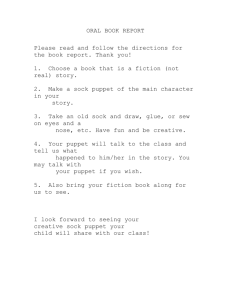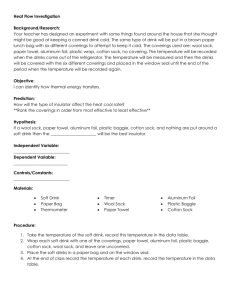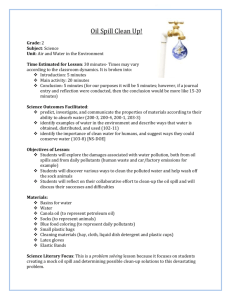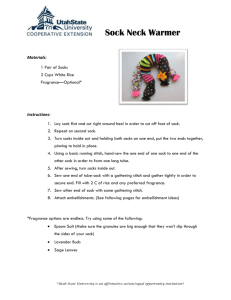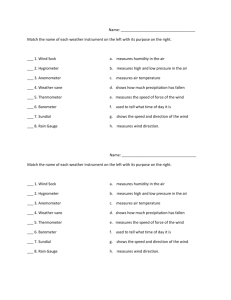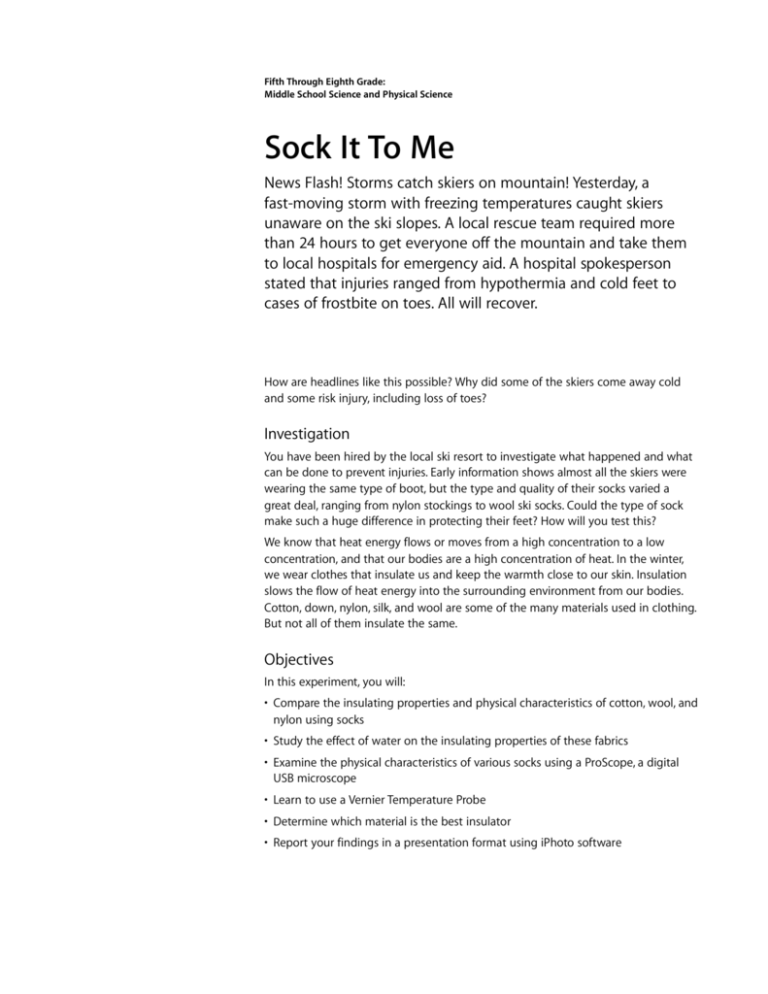
Fifth Through Eighth Grade:
Middle School Science and Physical Science
Sock It To Me
News Flash! Storms catch skiers on mountain! Yesterday, a
fast-moving storm with freezing temperatures caught skiers
unaware on the ski slopes. A local rescue team required more
than 24 hours to get everyone off the mountain and take them
to local hospitals for emergency aid. A hospital spokesperson
stated that injuries ranged from hypothermia and cold feet to
cases of frostbite on toes. All will recover.
How are headlines like this possible? Why did some of the skiers come away cold
and some risk injury, including loss of toes?
Investigation
You have been hired by the local ski resort to investigate what happened and what
can be done to prevent injuries. Early information shows almost all the skiers were
wearing the same type of boot, but the type and quality of their socks varied a
great deal, ranging from nylon stockings to wool ski socks. Could the type of sock
make such a huge difference in protecting their feet? How will you test this?
We know that heat energy flows or moves from a high concentration to a low
concentration, and that our bodies are a high concentration of heat. In the winter,
we wear clothes that insulate us and keep the warmth close to our skin. Insulation
slows the flow of heat energy into the surrounding environment from our bodies.
Cotton, down, nylon, silk, and wool are some of the many materials used in clothing.
But not all of them insulate the same.
Objectives
In this experiment, you will:
• Compare the insulating properties and physical characteristics of cotton, wool, and
nylon using socks
• Study the effect of water on the insulating properties of these fabrics
• Examine the physical characteristics of various socks using a ProScope, a digital
USB microscope
• Learn to use a Vernier Temperature Probe
• Determine which material is the best insulator
• Report your findings in a presentation format using iPhoto software
4
Fifth Through Eighth Grade:
Middle School Science and Physical Science
Materials
• Macintosh computer with Mac OS X
• iPhoto
• Bodelin ProScope with 50X lens
• Bodelin USB Shot software
• Vernier Temperature Probe
• Vernier Go! Link interface
• Vernier Logger Lite software
• Inkjet or laser printer (optional)
• One glass or plastic bottle
• One one-hole stopper
• Two wool socks, two nylon socks, and two cotton socks
• Hot water from faucet (40–50o C)
• Room temperature water
Procedure
1 In your science journal, write down which sock you think will be the best insulator
and explain why.
2 Obtain and wear goggles.
3 Touch the tip of the ProScope with the 50X lens to each type of fabric to create an
image. In your science journal, describe what you see for each sock. Based on what
you observe, modify your hypothesis if necessary. Print your images and place them
in your journal (optional).
4 Prepare the computer to collect temperature data:
a Connect the Temperature Probe to Go! Link.
b Connect Go! Link to the computer.
c Open the Logger Lite software.
d Choose Data Collection from the Experiment menu and set the experiment
length to 600 seconds.
e Click Done.
5 Obtain a bottle and a one-hole stopper to perform the first data run.
Note: Steps 5 and 6 must be performed quickly for good results.
a Fill the bottle up to the neck of the bottle with hot water.
b Insert the rubber stopper tightly into the bottle, then insert the Temperature
Probe into the hole in the stopper.
c Use a paper towel to dry the outside of the bottle.
Science CSI: Concentrated Science Investigation, Lesson 1
Sock It To Me
5
6 Collect your first data run:
a Click the Collect button
600 seconds.
to begin data collection. Data collection will last for
b When data collection ends, click the Examine button
. The Examine box
appears on the screen. As you move the pointer across the graph, the
temperature and time values are displayed in the Examine box.
c Move the pointer around the graph until you find the maximum and minimum
temperatures. Record the maximum and minimum temperatures in the data table
as your control data.
d Close the Examine box by clicking the upper-left corner of the box.
e Store this run by clicking the Store button
.
7 Remove the one-hole stopper and Temperature Probe from the bottle. Refill the
bottle with hot water and replace the Temperature Probe into the bottle. This time
place your bottle in one of the socks. Make sure to cover as much of the bottle as
possible. As soon as you have the bottle in the sock, repeat Step 6, only this time
record your ending temperature as your first experimental data run.
8 Repeat Step 6 for the other socks. Make sure to record your data at the completion
of each of the experimental runs.
9 For the wet sock trials, wet each of the socks with water and wring the excess water
from the sock. Examine each sock with the ProScope for changes in the material.
Record an image for each sock. Print the images and place them in your journal
(optional). Make sure you identify each of your images. Later, you will transfer the
image files to an iPhoto album.
10 If time permits, repeat Step 6, placing the bottle in the different wet socks. Record
your data and print the final graph. (Printing is optional.)
11 Locate the Snap folder created by USB Shot and import it into iPhoto for analysis
and captioning. Make sure you have identified the images before you transfer them
to iPhoto.
12 After all the experiments are done, compile the data into a single iPhoto slideshow.
©2005 Apple Computer, Inc. All rights reserved. For classroom use only
6
Fifth Through Eighth Grade:
Middle School Science and Physical Science
Processing the data
Image From
ProScope
Maximum
Minimum
Temperature Temperature
(Can be pasted,
drawn, or inserted
in an electronic
document)
Temperature
Change
(Maximum
Temperature
– Minimum
Temperature)
Wool Sock
°C
°C
°C
Wet Wool Sock
°C
°C
°C
Cotton Sock
°C
°C
°C
Wet Cotton Sock
°C
°C
°C
Nylon Sock
°C
°C
°C
Wet Nylon Sock
°C
°C
°C
Science CSI: Concentrated Science Investigation, Lesson 1
Sock It To Me
7
Analyzing your data
1 In the space provided in the data table, subtract the minimum temperature from the
maximum temperature to find the temperature change.
2 Compare the insulation abilities of wool, nylon, and cotton. Which one insulates the
best?
3 Discuss the differences you can see in your ProScope examination of each sock.
4 Discuss why and how each material slows the transfer of heat.
5 What happened to the temperature of the water in the bottle covered with the wet
sock? Explain this effect.
6 What do the results of this experiment suggest about wet clothing in cold weather?
7 What was the purpose of the uncovered bottle in this experiment?
©2005 Apple Computer, Inc. All rights reserved. For classroom use only
8
Fifth Through Eighth Grade:
Middle School Science and Physical Science
Teacher Information
Hypothesis
This experiment is designed to promote student observation, questioning, and
presenting possible explanations. One of the first activities you can do is provide a
simple demonstration of heat being lost from hot water to the surrounding
environment. The identification of the problem can be something that students
have observed or experienced themselves. In this experiment, allow students to
form their own questions as part of the investigation and develop possible
explanations or hypotheses. Here is an example of a question and hypothesis:
Question: Which sock material will be the best insulator?
Hypothesis: The sock that has a fabric that creates the greatest amount of trapped
air (has the most air space) will be the best insulator.
Science concepts
Transfer of energy and the flow of energy are difficult concepts for students because
of the lack of visual and manipulative materials. This experiment provides both
aspects and allows students to study basic concepts of energy. The basic principle of
the experiment is that the construction of socks with various materials traps air next
to the skin. The heat from the skin heats the air trapped in the sock material. This
provides a buffer against the cold air of the surrounding environment. This is very
effective when there is little exchange of air with the environment.
Different materials or fabrics have different structures, which can be seen under the
ProScope. Generally, the more air trapped and the less air exchanged with the
environment, the better the insulation property of the material. When the material is
wet, two processes are at work. First, the amount of water in direct contact with the
skin requires more heat from the body to come to equilibrium. Second, in the air,
the water evaporates and acts as a cooling agent on the bottle, much like wet
canvas cloths on old metal canteens. In very wet situations, the constant exchange
of water next to the skin rapidly removes heat and lowers body temperatures
quickly.
The second law of thermodynamics states that wherever there is any kind of energy,
that energy (if it is not hindered from doing so) must flow away from the energy
source into the universe. Once this energy is lost, the reverse action—energy
flowing back into the object on its own—can never happen. That is, if two objects
are placed in thermal contact with each other, heat from the warmer object flows
into the cooler one. Heat energy never flows from the cooler object to the warmer
object. The law also states that a system with more energy than its environment will
always try to come to equilibrium with its surroundings. This is also known as the
law of entropy. This experiment provides a physical activity that demonstrates that
principle.
Science CSI: Concentrated Science Investigation, Lesson 1
Sock It To Me
9
Facilitation tips
The experiment is rather simple, but can be time consuming with a single
Temperature Probe. If you have several probes, direct comparisons can be made,
cutting down on the number of runs. With a single probe, the experiment can be
run in one period. The analysis and creation of the presentation will take one
additional period. The following strategies may help with the time issue.
1 The instructor sets up the control bottle #1 in the front of the room and projects
or records the control temperature for the lab. This strategy cuts down on the
required equipment. Each group will only need one bottle and one probe.
2 Divide the class into three groups and have each group test only one fabric for its
insulating properties. Record and project the results so all the groups can share
the data.
3 For the wet trials, the instructor can set up the control bottles in the front of the
room and share the data. The students will only have to record data for their wet
bottle.
4 Demonstrate locating the Snap folder from USB Shot and show how to import
the JPEG images prior to the experiment.
5 Demonstrate how to provide labels for images in iPhoto and how to create a
slideshow prior to the experiment.
Expected outcomes
Since the wool sock has excellent loft compared to the other fabrics, it should
provide the best heat retention. Cotton would be next, followed by nylon. In
addition to the material, the type of weave and the thickness of the fibers are
variables that affect the outcomes. The project is designed to demonstrate these
properties.
Data
Students have four separate complete sets of data to collect:
• Dry sock cooling rate and change of temperature
• Dry sock ProScope images
• Wet sock cooling rate and change of temperature
• Wet sock ProScope images
©2005 Apple Computer, Inc. All rights reserved. For classroom use only
10
Fifth Through Eighth Grade:
Middle School Science and Physical Science
Sample results
Image From
ProScope
Maximum
Minimum
Temperature
Temperature Temperature Change
(Can be pasted,
drawn, or inserted
in an electronic
document)
(Maximum
Temperature
– Minimum
Temperature)
Wool Sock
80.0°C
77.4°C
2.6°C
Wet Wool Sock
80.0°C
76.3°C
3.7°C
Cotton Sock
80.0°C
76.9°C
3.1°C
Wet Cotton Sock
80.0°C
71.7°C
8.3°C
Nylon Sock
80.0°C
74.5°C
5.5°C
Wet Nylon Sock
80.0°C
72.0°C
8.0°C
Science CSI: Concentrated Science Investigation, Lesson 1
Sock It To Me
©2005 Apple Computer, Inc. All rights reserved. For classroom use only
11
12
Fifth Through Eighth Grade:
Middle School Science and Physical Science
Science CSI: Concentrated Science Investigation, Lesson 1
Sock It To Me
13
Answers to analyzing your data questions
1 Answers will be based on data and calculations.
2 Generally, students should conclude that wool is the best insulator.
3 In the ProScope examination, the wool fiber should look rather loose with many
tiny spaces. Nylon would have the most amount of air space visible because of
the smooth construction of the synthetic fiber. Cotton would have a tighter
weave than nylon, but include looser fibers than wool.
4 Each material has a different structure. These differences allow each material to
be more or less efficient at trapping and exchanging air with the surrounding
environment. Generally, the more air that is trapped by a material and provides
the least loss to the environment is the best insulator.
5 The temperature lowers.
6 In really cold weather, water evaporates less, but is denser than the surrounding
air. In this case, the water acts as an insulator against really cold air. This principle
is seen in the winter when citrus trees are spread with water to prevent the
freezing of the fruit on a tree. The ice prevents the fruit from coming in contact
with the frigid air. When the environment is much warmer, the water evaporates
and draws heat away from the bottle, lowering the temperature quickly.
7 The uncovered bottle provides control data for the experiment.
©2005 Apple Computer, Inc. All rights reserved. For classroom use only
14
Fifth Through Eighth Grade:
Middle School Science and Physical Science
Science standards alignment
This experiment provides direct alignment to national standards by allowing
students to actually see and measure heat energy transfer. The design of the
experiment also emphasizes alignment with measurement, inquiry, and investigative
standards by having students use technology to practice and gain insight into these
skills.
National Science Standards
Unifying Concepts and Processes:
1 Evidence, models, and explanation.
2 Change, constancy, and measurement.
Science as Inquiry
Content Standard A
As a result of activities, students should develop
1 Abilities necessary to do scientific inquiry.
2 Understandings about scientific inquiry.
National Content Standards
Level 5-8. Physical Science Standards
Content Standard B. Transfer of Energy:
Heat moves in predictable ways, flowing from warmer objects to cooler ones, until
both reach the same temperature.
Science CSI: Concentrated Science Investigation, Lesson 1
Sock It To Me
15
National Educational Technology Standards. (ISTE)
Standards Categories
1 Basic operations and concepts
3 Technology productivity tools
4 Technology communication tools
5 Technology research tools
6 Technology problem-solving and decision-making tools
Performance Indicators
1 Use content-specific tools, software, and simulations (e.g., environmental probes,
graphing calculators, exploratory environments, Web tools) to support learning
and research.
2 Apply productivity/multimedia tools and peripherals to support personal
productivity, group collaboration, and learning throughout the curriculum.
3 Design, develop, publish, and present products (e.g. Web pages, videotapes) using
technology resources that demonstrate and communicate curriculum concepts to
audiences inside and outside the classroom.
4 Collaborate with peers, experts and others using telecommunications and
collaborative tools to investigate curriculum-related problems, issues and
information, and to develop solutions or products for audiences inside and
outside the classroom.
5 Select and use appropriate tools and technology resources to accomplish an
variety of tasks to solve problems.
Learn more
If you enjoyed this hands-on science experiment, learn more about the Science CSI
Kit and additional curriculum lessons that can be used for concentrated science
investigations at: http://www.apple.com/education/sciencecsikit.
Special thanks
This experiment was written by Dr. Bruce Ahlborn, Technology Coordinator of the
Northbrook School District, Northbrook, IL, and edited by Bruce Payne, Apple
Professional Development consultant.
©2005 Apple Computer, Inc. All rights reserved. For classroom use only


